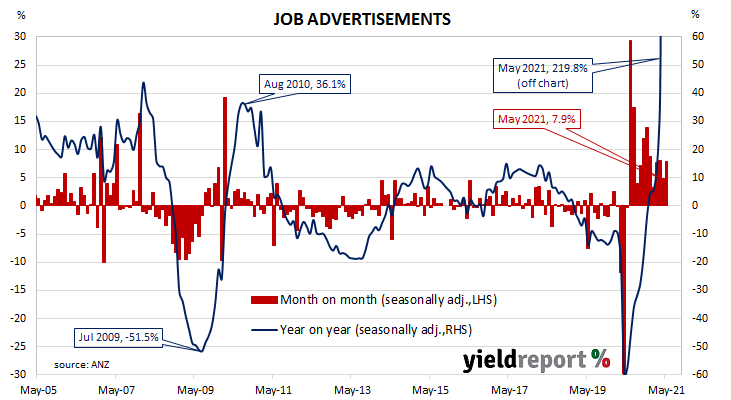Summary: Job ads up again in May; ads double same month in 2020; consistent with 5% jobless rate; “employment growth will be very strong”; ANZ expects jobless rate to hit 4.8% by end of this year.
From mid-2017 onwards, year-on-year growth rates in the total number of Australian job advertisements consistently exceeded 10%. That was until mid-2018 when the annual growth rate fell back markedly. 2019 was notable for its reduced employment advertising and this trend continued into the first quarter of 2020. Figures plunged in April and May of 2020 as pandemic restrictions took effect but then recovered relatively quickly.
According to the latest ANZ figures, total advertisements increased by 7.9% in May on a seasonally-adjusted basis. The rise followed a 4.9% increase in April and an 8.0% gain in March after revisions. On a 12-month basis, total job advertisements were 219.8% higher than in May 2020, up from April’s comparable figure of 195.5%.
“ANZ Job Ads hit 12 straight months of gains in May and is now consistent with an unemployment rate of around 5%,” said ANZ senior economist Catherine Birch.

Commonwealth bond yields fell moderately on the day, following noticeably-lower long-term US Treasury bond yields from Friday night. By the close of business, the 3-year ACGB yield had slipped 1bp to 0.21%, the 10-year yield had lost 5bps to 1.58% while the 20-year yield finished 4bps lower at 2.29%.
Birch noted the figures are “unlikely to fully translate into employment, due to skills mismatches and restricted labour mobility” but “employment growth will be very strong, particularly given such low population growth.” ANZ currently expects Australia’s jobless rate to hit 4.8% by the end of this year and 4.4% by the end of 2022.
The inverse relationship between job advertisements and the unemployment rate has been quite strong (see below chart), although ANZ themselves called the relationship between the two series into question in early 2019. A rising number of job advertisements as a proportion of the labour force is suggestive of lower unemployment rates in the near-future. A falling ratio suggests higher unemployment rates will follow.

